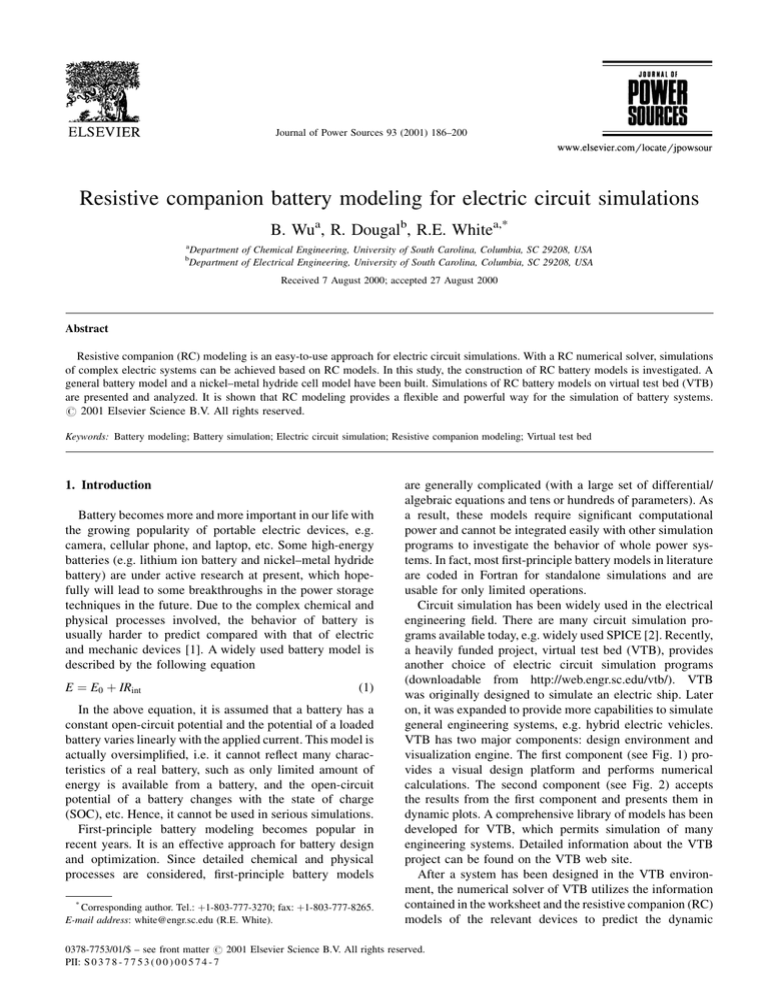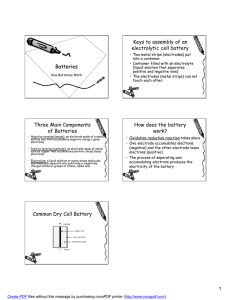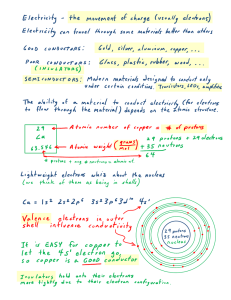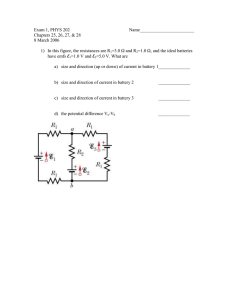
Journal of Power Sources 93 (2001) 186±200
Resistive companion battery modeling for electric circuit simulations
B. Wua, R. Dougalb, R.E. Whitea,*
a
Department of Chemical Engineering, University of South Carolina, Columbia, SC 29208, USA
Department of Electrical Engineering, University of South Carolina, Columbia, SC 29208, USA
b
Received 7 August 2000; accepted 27 August 2000
Abstract
Resistive companion (RC) modeling is an easy-to-use approach for electric circuit simulations. With a RC numerical solver, simulations
of complex electric systems can be achieved based on RC models. In this study, the construction of RC battery models is investigated. A
general battery model and a nickel±metal hydride cell model have been built. Simulations of RC battery models on virtual test bed (VTB)
are presented and analyzed. It is shown that RC modeling provides a ¯exible and powerful way for the simulation of battery systems.
# 2001 Elsevier Science B.V. All rights reserved.
Keywords: Battery modeling; Battery simulation; Electric circuit simulation; Resistive companion modeling; Virtual test bed
1. Introduction
Battery becomes more and more important in our life with
the growing popularity of portable electric devices, e.g.
camera, cellular phone, and laptop, etc. Some high-energy
batteries (e.g. lithium ion battery and nickel±metal hydride
battery) are under active research at present, which hopefully will lead to some breakthroughs in the power storage
techniques in the future. Due to the complex chemical and
physical processes involved, the behavior of battery is
usually harder to predict compared with that of electric
and mechanic devices [1]. A widely used battery model is
described by the following equation
E E0 IRint
(1)
In the above equation, it is assumed that a battery has a
constant open-circuit potential and the potential of a loaded
battery varies linearly with the applied current. This model is
actually oversimpli®ed, i.e. it cannot re¯ect many characteristics of a real battery, such as only limited amount of
energy is available from a battery, and the open-circuit
potential of a battery changes with the state of charge
(SOC), etc. Hence, it cannot be used in serious simulations.
First-principle battery modeling becomes popular in
recent years. It is an effective approach for battery design
and optimization. Since detailed chemical and physical
processes are considered, ®rst-principle battery models
*
Corresponding author. Tel.: 1-803-777-3270; fax: 1-803-777-8265.
E-mail address: white@engr.sc.edu (R.E. White).
are generally complicated (with a large set of differential/
algebraic equations and tens or hundreds of parameters). As
a result, these models require signi®cant computational
power and cannot be integrated easily with other simulation
programs to investigate the behavior of whole power systems. In fact, most ®rst-principle battery models in literature
are coded in Fortran for standalone simulations and are
usable for only limited operations.
Circuit simulation has been widely used in the electrical
engineering ®eld. There are many circuit simulation programs available today, e.g. widely used SPICE [2]. Recently,
a heavily funded project, virtual test bed (VTB), provides
another choice of electric circuit simulation programs
(downloadable from http://web.engr.sc.edu/vtb/). VTB
was originally designed to simulate an electric ship. Later
on, it was expanded to provide more capabilities to simulate
general engineering systems, e.g. hybrid electric vehicles.
VTB has two major components: design environment and
visualization engine. The ®rst component (see Fig. 1) provides a visual design platform and performs numerical
calculations. The second component (see Fig. 2) accepts
the results from the ®rst component and presents them in
dynamic plots. A comprehensive library of models has been
developed for VTB, which permits simulation of many
engineering systems. Detailed information about the VTB
project can be found on the VTB web site.
After a system has been designed in the VTB environment, the numerical solver of VTB utilizes the information
contained in the worksheet and the resistive companion (RC)
models of the relevant devices to predict the dynamic
0378-7753/01/$ ± see front matter # 2001 Elsevier Science B.V. All rights reserved.
PII: S 0 3 7 8 - 7 7 5 3 ( 0 0 ) 0 0 5 7 4 - 7
B. Wu et al. / Journal of Power Sources 93 (2001) 186±200
Nomenclature
aneg
apos
Aneg
Apos
b
B
ce
ce,ref
cMH
cMH,max
cMH,ref
cNi
OH2
cNi
OH2 ;max
cNi
OH2 ;ref
Cbat
E
E0
Eeq
f
F
F
g
G
i
i
i4,ref
icell
ik
io,k
j1
j2
j3
j4
J
specific surface area of the negative electrode (cm2/cm3)
specific surface area of the positive electrode (cm2/cm3)
geometry area of the negative electrode (cm2)
geometry area of the positive electrode (cm2)
equivalent current source of an electric
device (A)
current source vector (A)
concentration of KOH electrolyte (mol/
cm3)
reference concentration of KOH electrolyte
(mol/cm3)
concentration of hydrogen in metal hydride
(mol/cm3)
maximum concentration of hydrogen in
metal hydride (mol/cm3)
reference concentration of hydrogen in
metal hydride (mol/cm3)
concentration of Ni(OH)2 (mol/cm3)
maximum concentration of Ni(OH)2 (mol/
cm3)
reference concentration of Ni(OH)2 (mol/
cm3)
capacity of the battery (A h)
potential of a loaded battery (V)
standard potential of a battery (V)
open-circuit potential of a battery at a
particular state of charge (V)
linear or nonlinear equations
Faradic constant (98467 C/eq)
governing equations of voltage variables
equivalent conductance of an electric device (S)
conductance matrix (S)
current through an electric device (A)
vector of current (A)
rate of oxygen reaction at the reference
state (A/cm2)
current through a cell (A)
current on terminal k (A)
exchange current density of reaction k (A/
cm2)
current density due to the nickel reaction on
the positive electrode (A/cm2)
current density due to the oxygen reaction
on the positive electrode (A/cm2)
current density due to the hydrogen reaction
on the negative electrode (A/cm2)
current density due to the oxygen reaction
on the negative electrode (A/cm2)
Jacobian matrix with respect to voltage
variables
lneg
lpos
ly,neg
ly,pos
L
LMH
LNi
OH2
m
MMH
MNi
OH2
n
pO2
pO2 ;ref
R
Rint
SOC
t
T
u
U
Ueq,k,ref
v
v
vcell
vk
Vgas
y
187
thickness of the metal hydride electrode
(cm)
thickness of the nickel electrode (cm)
equivalent thickness of metal hydride
material (cm)
equivalent thickness of nickel active material (cm)
lower triangular matrix
loading of metal hydride material (g/cm2)
loading of nickel active material (g/cm2)
temporary vector in matrix manipulation
molecular weight of metal hydride material
(g/mol)
molecular weight of nickel active material
(g/mol)
electron transfer number of the whole
battery reaction
pressure of oxygen (atm)
reference pressure of oxygen (atm)
ideal gas constant (8.3143 J/mol/K)
internal resistance of a battery (O)
state of charge of the battery
independent time variable (s)
temperature (K)
vector of independent control variables
upper triangular matrix
equilibrium potential of reaction k at
reference reactant concentrations (V)
voltage across an electric device (V)
vector of voltages (V)
voltage through a cell (V)
voltage on terminal k (V)
gas volume in a nickel±metal hydride cell
(cm3)
vector of internal state variables
Greek letters
change of current due to the perturbation of
Dicell
the voltage (A)
perturbation of the voltage (V)
Dvcell
potential different at the solid±liquid interDfneg
face on the negative electrode (V)
potential different at the solid±liquid interDfpos
face on the positive electrode (V)
potential in the liquid phase on the negative
fneg;l
electrode (V)
potential in the solid phase on the negative
fneg;s
electrode (V)
potential in the liquid phase on the positive
fpos;l
electrode (V)
potential in the solid phase on the positive
fpos;s
electrode (V)
density of metal hydride active material (g/
rMH
cm3)
rNi
OH2
density of nickel active material (g/cm3)
188
B. Wu et al. / Journal of Power Sources 93 (2001) 186±200
Fig. 1. The VTB design environment.
Fig. 2. The VTB visualization engine.
B. Wu et al. / Journal of Power Sources 93 (2001) 186±200
189
Fig. 4. Diagram of a battery RC model where vcell v1 ÿ v0 and
icell i1 ÿi0 . The matrices b and g are given in Eqs. (5) and (6).
Fig. 3. RC black box model of an electric device.
behavior of the system. For each electric device, a black box
RC model with some external terminals (see Fig. 3) [3] can
be used to describe its electric behavior. The governing
equations of the device are cast in the following form
i
f
_v; y_ ; v; y; u
(2)
1
f 2
_v; y_ ; v; y; u
0
where v is the vector of terminal voltages, i the vector of
terminal currents, y the vector of internal state variables and
u the vector of independent control variables.
A linear form of Eq. (2) is used by VTB, as given below
i
t
G11
tv
t G12
ty
t ÿ B1
t
(3)
G21
tv
t G22
ty
t ÿ B2
t
0
where G is the conductance matrix and B the current source
vector. For a nonlinear device, Eq. (3) is obtained by
linearizing the nonlinear governing equations with the Taylor series expansion.
The RC modeling approach essentially treats each electric
device as a system of conductors and current sources. A RC
model accepts the values of terminal voltages as input and
calculates the conductance matrix and the current source
vector as output. A dynamic RC model also needs to conduct
the integration of the differential equations for a speci®ed
time step. Each RC model only handles its own governing
equations. The RC numerical solver of VTB will take care of
the solving of all interconnected devices in a system. For a
dynamic system, at each time step the RC solver adjusts the
voltages of all connecting nodes in the electric circuit based
on the previous values until the numerical convergence is
achieved, i.e. the sum of incoming currents is approximately
zero at all connecting nodes. A summary of the algorithm
used by the RC solver is provided in the Appendix A, which
is essentially a nonlinear equation solving procedure based
on Newton's algorithm. More details can be found in the
studies by Cokkinides and Beker [3].
source device with two terminals, as shown in Fig. 4. For a
two-terminal electric device, RC modeling expects the
following relation
i gv ÿ b
(4)
The conductance is given by
g
di
dv
(5)
The current source is calculated by
b gv ÿ i
(6)
Put the relations among dependent variables into RC
matrix form, we have
I GV ÿ B
where
v
V 0
v1
i
I 0
i1
g ÿg
G
ÿg g
ÿb
B
b
(7)
(8)
(9)
(10)
(11)
The behavior of a battery is usually described in a set of
nonlinear equations (for dynamic equations, discretization
in time domain is needed) as given below
f
v; i; y 0
(12)
where y is a vector of state variables. To provide a RC battery
model, the conductance matrix and the current source vector
must be obtained from the governing equations of the
battery. Two battery models are presented subsequently to
demonstrate the details of the RC modeling approach.
2. RC modeling of batteries
2.1. A simple RC model for general batteries
Battery is a typical electric device with the input/output of
current and voltage. In fact, it can be treated as a nonlinear
A simple battery model was developed as an extension of
the widely used model Eq. (1). The governing equations of
190
B. Wu et al. / Journal of Power Sources 93 (2001) 186±200
2.2. RC model of a nickel±metal hydride cell
the model is given by
v Eeq iRint
(13)
where the equilibrium potential of the battery is a function of
the SOC of the battery and can be fitted directly from the
experimental data
Eeq f
SOC
(14)
If the following assumptions are valid: (i) the Nernst
equation is a valid description of the equilibrium potential
of the relevant electrochemical reactions; (ii) the main
electrochemical reactions on positive and negative electrodes have fast kinetics; (iii) the capacity of the positive
electrode roughly matches that of the negative electrode
(i.e. no precharge and surplus capacity on either electrode),
we have
RT
SOC
ln
(15)
Eeq E0
nF
1 ÿ SOC
Assuming no side reactions, then the relationship between
SOC and charge/discharge rate is given by
dSOC
i
dt
3600Cbat
(16)
The equivalent conductance and current source of the
model are calculated as follows
g
di
1
dv Rint
b gv ÿ i
(17)
Eeq
Rint
(18)
In matrix form, we have the RC model for general
batteries.
I GV ÿ B
(19)
where
2
1
1 3
ÿ
6
Rint 7
G 4 Rint1
1 5
ÿ
Rint Rint
2 E 3
eq
ÿ
6 Rint 7
B4 E 5
eq
(20)
The model presented here uses the planar electrode
approximation for both positive and negative electrodes,
i.e. each electrode is treated as a huge planar electrode with a
surface area equal to the total internal surface area of the
porous electrode. The diffusion process inside the solid
active material has been neglected. Since battery electrodes
are normally made to be very thin to minimize ohmic
resistance, a planar electrode model usually gives insignificant errors and costs much less computation compared with
a rigorous porous electrode model.
Four reactions in a nickel±metal hydride cell have been
considered (the hydrogen oxidation reaction on the nickel
electrode has been neglected), as listed below
Nickel electrode
discharge
NiOOH H2 Oeÿ @ Ni
OH2 OHÿ
(22)
2OHÿ ! 12 O2 H2 O 2eÿ
(23)
charge
Metal hydride electrode
discharge
MH OHÿ @ H2 O M eÿ
charge
1
2 O2
H2 O 2eÿ ! 2OHÿ
(24)
(25)
The main reaction on the positive electrode is the redox
reaction of nickel active material Eq. (22) while that on the
negative electrode is the redox reaction of metal hydride
material Eq. (24). The side reaction on the positive electrode
is oxygen evolution Eq. (23) while that on the metal hydride
electrode is oxygen reduction Eq. (25).
The kinetics of reactions Eqs. (22)±(24) can be described
with the Butler±Volmer equation
!
2
3
cNi
OH2
ce
0:5F
exp
Dfpos ÿ Ueq;1;ref 7
6
ce;ref
RT
6 cNi
OH2 ;ref
7
6
!
j1 i0;1 6
7
7
cNi
OH2
0:5F
4
5
ÿ 1ÿ
exp ÿ
Dfpos ÿUeq;1;ref
cNi
OH2 ;ref
RT
(26)
(21)
Rint
The above battery model is actually a linear model
between current and voltage. Due to its simplicity, computational requirement of the model is trivial. This model is
more realistic than Eq. (1) and can give reasonable predictions for many battery systems. However, it is still oversimpli®ed. First-principle modeling is needed to obtain
more accurate predictions and get mechanistic information
of a battery. An example is presented below for a nickel±
metal hydride cell.
2
3
F
Dfpos ÿ Ueq;2;ref
exp
6
7
ce;ref
RT
6
7
j2 i0;2 6 7
0:5
4
5
pO2
F
Dfpos ÿ Ueq;2;ref
exp ÿ
ÿ
pO2 ;ref
RT
(27)
3
2
cMH
ce
0:5F
Df
ÿ
U
exp
eq;3;ref 7
neg
6 cMH;ref
RT
ce;ref
6
7
j3 i0;3 6
7
4
5
0:5F
Dfneg ÿ Ueq;3;ref
ÿexp ÿ
RT
(28)
ce
2
B. Wu et al. / Journal of Power Sources 93 (2001) 186±200
where the potential difference at the solid±liquid interface
on each electrode is
Dfpos fpos;s ÿ fpos;l
(29)
Dfneg fneg;s ÿ fneg;l
(30)
Due to the huge electrochemical driving force for oxygen
reduction on the negative electrode, a limiting-current equation is used for the rate of reaction Eq. (25)
pO2
i4;ref
(31)
j4 ÿ
pO2 ;ref
The charge balances on the electrodes is described by
icell apos lpos Apos
j1 j2
(32)
ÿicell aneg lneg Aneg
j3 j4
(33)
The mass balances of nickel active material is given by
dcNi
OH2
j1
ÿ
ly;pos
dt
F
(34)
where the effective thickness of nickel active material is
ly;pos
LNi
OH2
rNi
OH2 lpos apos
(35)
The mass balance of metal hydride material is given by
ly;neg
dcMH
j4
ÿ
dt
F
(36)
where the effective thickness of metal hydride active material is
ly;neg
LMH
rMH lneg aneg
(37)
The mass balance equation of oxygen is given by
Vgas dpO2
apos lpos Apos j2 aneg lneg Aneg j4
RT dt
F
(38)
The separator is treated as an ohmic resistance, which gives
icell Rint fpos;l ÿ fneg;l
(39)
The cell potential is calculated by
vcell fpos;s ÿ fneg;s Dfpos ÿ Dfneg icell Rint
(40)
Due to the comparatively excess amount of metal hydride
material, the SOC of a nickel±metal hydride cell is given by
the charged state of nickel active material
cNi
OH2
(41)
SOC 1 ÿ
cNi
OH2 ;max
The initial setting of SOC for the model will be converted
into corresponding concentration of nickel active material
and metal hydride material, i.e.
c0Ni
OH
2
cNi
OH2 ;max
1 ÿ SOC0
(42)
c0MH
cMH;max
SOC0
191
LNi
OH2 Apos MMH
0:05
LMH Aneg MNi
OH2
(43)
In Eq. (43) metal hydride material has been set to be five
percent precharged
For an applied voltage vcell and an integration time step
Dt, six dependent variables: icell , cNi
OH2 , cMH , pO2 , Dfpos
and Dfneg need to be solved with the model. Applying
the implicit Euler method on the model equations
yields
new
ly;pos
old
cNi
OH ÿ cNi
OH
2
new
Dt
new
ÿ
old
j1
(44)
F
new
cMH ÿ cMH
j
ÿ 3
Dt
F
ly;neg
new
old
Vgas pO2 ÿ pO2
RT
Dt
new
icell
new
(45)
new
apos lpos Apos j2
new
apos lpos Apos
j1
new
ÿicell
vcell
2
new
aneg lneg Aneg
j3
new
j2
new
j4
new
aneg lneg Aneg j4
F
(46)
(47)
new
new
Df
new
pos ÿ Dfneg icell Rint
(48)
(49)
where the superscript `(old)' indicates the previous values
and superscript `(new)' the current values. It is worth noting
that the old values of algebraic variables icell , Dfpos and
Dfneg have no effect on the solution of the current values of
dependent variables because no time derivatives of these
variables appear in the governing equations. The above
equations, which can be written in the form of Eq. (12),
are solved with the nonlinear equation solver, general nonlinear equation solver (GNES) [4].
Analytical solutions for the RC matrices are not available
for the above model. The equivalent conductance g and
current source b of the RC battery model are obtained by
using ®nite difference approximations. That is, g is calculated by a ®nite difference approximation for di=dv in
Eq. (5). This approximation is obtained by ®rst setting
vcell followed by calculating icell and the other dependent
variables listed above by solving Eqs. (44)±(49). Next, a
small voltage Dvcell is added to vcell and the calculation is
repeated to obtain icell Dicell . These values are used to give
g and b
g
icell Dicell ÿ icell
vcell Dvcell ÿ vcell
b gvcell ÿ icell
icell Dicell ÿ icell
vcell ÿ icell
vcell Dvcell ÿ vcell
(50)
(51)
In matrix form, we have the RC model of the nickel±metal
hydride cell as follows
I GV ÿ B
(52)
192
B. Wu et al. / Journal of Power Sources 93 (2001) 186±200
where
2
3
icell Dicell ÿ icell
icell Dicell ÿ icell
ÿ
6
vcell Dvcell ÿ vcell
vcell Dvcell ÿ vcell 7
7
G6
4
icell Dicell ÿ icell
icell Dicell ÿ icell 5
ÿ
vcell Dvcell ÿ vcell
vcell Dvcell ÿ vcell
(53)
2
3
icell Dicell ÿ icell
6 ÿ
vcell Dvcell ÿ vcell vcell icell 7
7
(54)
B6
4
icell Dicell ÿ icell
5
vcell ÿ icell
vcell Dvcell ÿ vcell
The perturbation of the cell voltage Dvcell must be small
enough (e.g. 1 10ÿ4 V) to provide accurate numerical
approximations for G and B. The numerical approximation
of RC matrices essentially allows more complex battery
models to be treated as a linear model between current and
voltage at a speci®c time point.
Good ef®ciency and robustness are highly desirable for a
®rst-principle RC battery model. It is obvious that even with
the planar electrode approximation, the ®rst-principle model
of a nickel±metal hydride cell is highly nonlinear and
nontrivial to solve. In the simulation of a whole power
system, since a battery model may be called hundreds or
even thousand times by the RC solver, a slow model could
cause a simulation to last several days, which will be
intolerable for most projects. Normally, simpli®ed models
and good numerical solvers should be used to achieve
satisfactory calculation ef®ciency. In the RC approach,
the input to a battery models is terminal voltage values;
however, the behavior of a battery is highly sensitive to the
applied voltages, as is obvious from the exponential dependence of battery current on the voltage values in Eqs. (26)±
(28). Some guess values from the RC solver can easily lead
to numerical dif®culty of a battery model. Thus a RC battery
model needs to be built robust enough to avoid numerical
failures of the whole simulation.
3. Results and discussions
To incorporate a RC model into VTB, a dynamic link
library (DLL) ®le needs to be constructed based on the C
interface speci®ed by Cokkinides and Beker [3]. The DLL
®le of a RC model can be debugged independently. VTB will
accept and use the DLL ®le of a user-built RC model as it
does with native RC models. Communication between a RC
model and the VTB is through the exchange of model
parameters and RC matrices. Sample source code has been
provided by Cokkinides and Beker [3] to facilitate the
construction of RC models for the VTB environment. A
C class of a battery model is derived from the base class
CCompanionDevice. The following subroutines need to be
de®ned (supposing BatModel is the name of our battery
model class):
BatModel::BatModel(), defines model parameters and
states;
BatModel::GuiToInternal(), converts user settings to
internal model parameters;
BatModel::GetVectorIcon(short vicondata), provides the
icon of the model;
Fig. 5. The parameter setting dialog for the simple RC model of general batteries.
B. Wu et al. / Journal of Power Sources 93 (2001) 186±200
193
Table 1
Parameters for the simplified model of general batteries
Parameter
Value
Cbat (A h)
E0 (V)
n
Rint (O)
1.0
1.25
1.0
1.0 10ÿ2
Fig. 6. Worksheet of sample simulation I: two batteries with initial SOC of
25% connected with a battery with initial SOC of 85%.
BatModel::TdsInitExt(DEV_INTERFACE tdsi, double
vol, double beq, double con), initializes model states
and provides VTB with initial RC matrices;
BatModel::TdsStepExt(DEV_INTERFACE tdsi), calculates the model states and RC matrices based on the
voltage input from VTB RC solver.
After the DLL of a RC model has been developed, it needs
to be put into a speci®ed directory to be accepted by VTB.
Using a RC model is straightforward in VTB. To create a
model object, one selects the corresponding model item
from menus or toolbars. The model object is represented by
an icon and can be moved around in the VTB worksheet. The
Fig. 8. Worksheet of sample simulation II: a capacitor and an inductor
connected in series with a battery with initial SOC of 95%.
parameters of an object can be easily modi®ed through a
dialog box (see Fig. 5) invoked by double-clicking the icon
of the object.
Two simulations are given for the simple RC model of
general batteries. The parameters of the battery model are
listed in Table 1. In Fig. 6, three batteries are connected
together. The SOCs of the ®rst two batteries are set to be
25%, and the SOC of the third one is set to be 85%. However,
as shown in Fig. 7, it is predicted that two less charged
batteries connected in series can actually produce a voltage
high enough to charge a near fully charged battery in 15 s,
which is quite an unintuitive result (and a fact in reality). In
Fig. 8, a battery with an initial SOC of 95% is connected
with a 1C capacitor and a 1H inductor. The simulation
results in Figs. 9 and 10 show fast transient behavior of
voltage and current. The capacitor is charged while the
battery is discharged at ®rst. When the capacitor is near
fully charged, the current in the circuit approaches zero (the
capacitor is essentially open-circuit after fully charged) and
the battery voltage approaches the open circuit potential of
the battery. Since the battery discharge process only lasts for
10 s, the SOC of the battery only slightly decreases, as
shown in Fig. 11.
Fig. 7. Predicted voltage of battery 3 in simulation I.
Fig. 9. Predicted voltage of the battery in simulation II.
Fig. 10. Predicted current of the battery in simulation II.
Fig. 11. Predicted SOC of the battery in simulation II.
B. Wu et al. / Journal of Power Sources 93 (2001) 186±200
195
Table 2
Parameters for the model of a nickel±metal hydride cell
Parameter
2
Value
3
apos (cm /cm )
aneg (cm2/cm3)
Apos (cm2)
Aneg (cm2)
ce (mol/cm3)
ce,ref (mol/cm3)
cMH,max (mol/cm3)
cMH,ref (cMH,max)
cNi
OH2 ;max (mol/cm3)
cNi
OH2 ;ref (cNi
OH2 ;max )
io,1 (A/cm2)
io,2 (A/cm2)
io,3 (A/cm2)
io,4 (A/cm2)
lpos (cm)
lneg (cm)
LNi
OH2 (g/cm2)
LMH (g/cm2)
MNi
OH2 (g/mol)
MMH (g/mol)
p0O2 (atm)
pO2 ;ref (atm)
Rint (O)
SOC0
Dt (s)
T (K)
Ueq;1;ref (V)
Ueq;2;ref (V)
Ueq;3;ref (V)
Vgas (cm3)
rNi
OH2 (g/cm3)
rMH (g/cm3)
4000.0
1000.0
325.0
360.0
7.0 10ÿ3
1.0 10ÿ3
1.0 10ÿ1
0.5
3.7 10ÿ2
0.5
1.0 10ÿ4
1.0 10ÿ10
3.8 10ÿ4
1.0 10ÿ4
3.3 10ÿ2
2.8 10ÿ2
6.8 10ÿ2
1.13 10ÿ1
92.71
70.58
1.0 10ÿ2
1.0
1.0 10ÿ3
0.95
1.0 10ÿ1
298.15
0.527
0.4011
ÿ0.8279
1.0 10ÿ1
3.4
7.49
Fig. 13. Worksheet of sample simulation III: a nickel±metal hydride cell
with initial SOC of 95% discharges through a 100 m O resistor.
Two simulations are provided for the RC model of a
nickel±metal hydride cell. The parameters of the nickel±
metal hydride cell model are listed in Table 2. The parameters used as the `old' variables for the initial conditions
are shown with a superscript `0' in Table 2. Fig. 12 shows the
parameter dialog for the model in VTB. In Fig. 13, a nickel±
metal hydride cell with an initial SOC of 95% is connected
with a constant resistor of 100 m O. The simulated current in
circuit is shown in Fig. 14. It is observed that with the drain
of SOC of the nickel±metal hydride cell, the current in the
circuit gradually decreases, and at the end of the discharge
process, the current drops rapidly to zero. Since the cell is
connected to a constant resistor, the cell voltage curve
similar to Fig. 14 can be expected.
The simulated SOC and hydrogen concentration in the
metal hydride electrode are shown in Figs. 15 and 16,
respectively. Approximately constant depletion rate of
the cell capacity is predicted. It is shown that only half
of metal hydride active material is utilized, which is
Fig. 12. The parameter setting dialog for the nickel±metal hydride cell model.
Fig. 14. Predicted current of the cell in simulation III.
Fig. 15. Predicted SOC of the cell in simulation III.
Fig. 16. Predicted mol fraction of hydrogen on the metal hydride electrode of the cell in simulation III.
B. Wu et al. / Journal of Power Sources 93 (2001) 186±200
197
Fig. 17. Predicted oxygen pressure of the cell in simulation III.
consistent with the positive-limited design of the battery.
The predicted oxygen pressure in the nickel±metal
hydride cell is given in Fig. 17. It indicates that the oxygen pressure decreases gradually with discharge time.
As shown in Fig. 18, the potential difference at the solid±
liquid interface on the positive nickel electrode gradually
decreases at ®rst, and at the end of the discharge process,
it changes rapidly to a negative value. In Fig. 19, however,
it is shown that the potential difference at the solid±
liquid interface on the negative metal hydride electrode
only slightly changes during the whole discharge process.
It is observed that at the end of the discharge process,
the potential difference at the solid±liquid interface on
the positive electrode is equal to that on the negative
electrode and causes zero current across the cell (and whole
circuit).
A simulation involving two nickel±metal hydride cells is
shown in Fig. 20. The initial SOCs of two cells are set to be
different. The initial SOC of the ®rst one is 95% and that of
the second one is 75%. The predicted discharge current is
shown in Fig. 21. As can be expected, due to the high voltage
of two serially connected nickel±metal hydride cells, the
current in the circuit almost doubles that with a single
nickel±metal hydride cell. The predicted SOCs in two cells
are given in Figs. 22 and 23. It is interesting to note that the
less charged cell determines the utilization of both cells, i.e.
Fig. 18. Predicted potential difference at solid±liquid interface on the nickel electrode of the cell in simulation III.
198
B. Wu et al. / Journal of Power Sources 93 (2001) 186±200
Fig. 19. Predicted potential difference at solid±liquid interface on the metal hydride electrode of the cell in simulation III.
Fig. 20. Worksheet of sample simulation IV: two nickel±metal hydride
cells with different initial SOCs discharge through a 100 m O resistor.
when the second nickel±metal hydride cell gets fully discharged, it blocks the discharge of the unused capacity of the
®rst cell. Thus, it con®rms a common sense in the battery
industry, i.e. it is not wise to use two cells with different
SOCs.
RC modeling easily allows simulations with multiple
objects of the same model, i.e. once a RC model is built,
it can be repeatedly used for many objects in a complex
system model. This is somewhat different from the conventional battery modeling approach, e.g. if two connected
batteries are to be simulated, a more complex model based
on the single battery model is required, which is usually a
nontrivial task. Usually different objects of the same model
may have different parameters, and they are handled simultaneously with the RC solver. It is obvious that challenging
battery simulations can be more easily conducted with
the RC modeling approach in a simulation environment
Fig. 21. Predicted current of the cell in simulation IV.
B. Wu et al. / Journal of Power Sources 93 (2001) 186±200
199
Fig. 22. Predicted SOC of the first nickel±metal hydride cell in simulation IV.
Fig. 23. Predicted SOC of the second nickel±metal hydride cell in simulation IV.
(e.g. in VTB) than with the direct modeling and coding
approach.
4. Conclusions
Fig. 24. Schematic diagram of the RC model objects for the worksheet in
Fig. 20.
The simulation of interactions among batteries and other
electric devices is usually a nontrivial task. In this study, the
RC battery modeling for electric circuit simulation is presented. Two RC battery models (a general battery model and
a nickel±metal hydride cell model) are demonstrated on the
VTB platform. It is shown that challenging simulations
involving batteries and other electric devices can be easily
handled with the RC modeling approach.
200
B. Wu et al. / Journal of Power Sources 93 (2001) 186±200
0
2
(A.9)
1
2
(A.10)
Appendix A. Algorithm of the RC solver in VTB
i1 i 1 0
For an electric circuit system, from the charge conservation and RC model equations, we have the governing
equations for the dependent voltage variables v at connecting
nodes.
n
X
gv b 0
(A.1)
F
v
i2 i2 0
i1
The Jacobian matrix of the above equation with respect to
v is given by
J
v
n
dF
v X
g
dv
i1
(A.2)
The Newton iteration can be used to solve the dependent
voltage variables.
vk1 vk ÿ J ÿ1
vk F
vk
(A.3)
To get the new iteration values with Eq. (A.3), the
inversion of Jacobian matrix is not conducted due to the
ef®ciency and robustness considerations. Instead, LU
decomposition procedure is used. First, J
xk is decomposed
into upper and lower triangle matrices
J
vk LU
(A.4)
Then the following equation is obtained
k
LU
v ÿ v
k1
k
F
v
(A.5)
which can be solved by forward and backward substitution
processes, i.e. solve
Lm F
vk
(A.6)
for vector m, then solve
k
U
v ÿ v
k
k1
(A.7)
k1
and finally get v .
for v ÿ v
For example, to solve the circuit of three RC model
objects connected together in Fig. 20, we have three dependent variables v0 , v1 and v2 (see Fig. 24). The governing
equations for them are
0
1
i0 i0 0
(A.11)
(A.12)
(A.13)
Substitution of Eqs. (A.11)±(A.13) into Eqs. (A.8)±(A.10)
yields
2
0
32 3
1
0
1
ÿg01
ÿg01
g00 g00
v0
6
76 7
0
2
2
6 ÿg
0
7
g11 g00
ÿg01 54 v1 5
4
10
1
2
1
2
v2
ÿg10
ÿg10
g11 g11
2
0
3
2 3
1
b b
0
6 0
0 0
2 7 6 7
6
7
(A.14)
ÿ 4 ÿb1 b0 5 4 0 5
1
2
0
ÿb ÿ b
1
1
It is obvious that as long as the RC parameters are
provided by RC models, the values of v0 , v1 and v2 can
be easily solved from Eq. (A.14). More complex electric
circuits can be solved in the same way. The construction of
the governing equations like Eq. (A.14) of the whole simulated system is automatically handled by VTB.
References
m
k1
The RC modeling gives
# "
#
"
0 #
0
0
0 v0
g00 ÿg01
b0
i0
ÿ
0
0
0
0
v
1
ÿg10 g11
i1
ÿb1
"
# "
#
"
1 #
1
1
1 v0
g00 ÿg01
b0
i0
ÿ
1
1
1
1
v2
ÿg10 g11
i2
ÿb1
"
# "
#
"
2 #
2
2
2
v1
g00 ÿg01
b0
i1
ÿ
2
2
2
2
v
2
i2
ÿg10 g11
ÿb1
"
(A.8)
[1] J.S. Newman, Electrochemical Systems, 2nd Edition, Prentice-Hall,
Englewood Cliffs, NJ, 1991.
[2] P.W. Tuinenga, Spice: A Guide to Circuit Simulation and Analysis
Using Pspice, 3rd Edition, Prentice-Hall, Englewood Cliffs, NJ,
1991.
[3] G. Cokkinides, B. Beker, RC and AC models in the VTB time domain
solver, Department of Electrical and Computer Engineering, University of South Carolina, 1998.
[4] B. Wu, R.E. White, Comput. Chem. Eng. (2000), in press.





